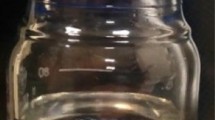Abstract
Chemical modification of wood is an established approach to improve its biological durability, water repellence, dimensional stability, and UV resistance. Norway spruce wood (Picea abies) in dry state, however, has an extraordinarily high recalcitrance towards impregnation with liquid modification reagents as drying triggers the irreversible closure of pits, i.e. the cell-to-cell valves in softwood. In the present study, it is shown that supercritical carbon dioxide is a highly suitable impregnation medium to overcome the recalcitrance of dry spruce wood. This has been exemplarily demonstrated for deca(dimethylsiloxane)-α,ω-diglycidylether (D8M OG2 ), a linear oligosiloxane with terminal epoxy-functionalities, which could be loaded into respective wood samples affording a weight gain of up to 63%. The thermally assisted reaction of the epoxy-functional siloxane with the wood polymers was catalysed with ring-opening Tin (II) octoate. The effort resulted in a remarkably reduced wettability with water, as evident from contact angle measurements (~ 140°), and in a significant decrease (≤ 20%) of the sample’s sensitivity towards moisture-induced dimensional changes.








Similar content being viewed by others
References
Bakar BFA, Hiziroglu S, Tahir PM (2013) Properties of some thermally modified wood species. Mater Des 43:348–355
Comstock G, Côté W Jr (1968) Factors affecting permeability and pit aspiration in coniferous sapwood. Wood Sci Technol 2:279–291
De Melo M, Silvestre A, Silva C (2014) Supercritical fluid extraction of vegetable matrices: applications, trends and future perspectives of a convincing green technology. J Supercrit Fluids 92:115–176
Deerberg G, Danzig J, Jelen E (2006) Modifizierung von einheimischen Hölzern durch Imprägnierung mit überkritischem Kohlendioxid (Modification of local wood species using supercritical carbon dioxide). Frauenhofer-Institut für Umwelt-, Sicherheits- und Energietechnik Oberhausen UMSICHT, Oberhausen
Demessie ES, Hassan A, Levien KL, Kumar S, Morrell JJ (1995) Supercritical carbon dioxide treatment: effect on permeability of Douglas-fir heartwood. Wood Fiber Sci 27:296–300
DIN EN 84:1997-05 Wood preservatives—accelerated ageing of treated wood prior to biological testing—Leaching procedure (1997)
Donath S, Militz H, Mai C (2004) Wood modification with alkoxysilanes. Wood Sci Technol 38:555–566
Eastman SA, Lesser AJ, McCarthy TJ (2009) Supercritical CO2-assisted, silicone-modified wood for enhanced fire resistance. J Mater Sci 44:1275–1282
Englund F, Bryne LE, Ernstsson M, Lausmaa J, Wålinder M (2009) Spectroscopic studies of surface chemical composition and wettability of modified wood. Wood Mater Sci Eng 4:80–85
Esteves BM, Pereira HM (2009) Wood modification by heat treatment: a review. BioResources 4:370–404
Ghosh SC, Militz H, Mai C (2009) Natural weathering of Scots pine (Pinus sylvestris L.) boards modified with functionalised commercial silicone emulsions. BioResources 4:659–673
Gindl M, Reiterer A, Sinn G, Stanzl-Tschegg S (2004) Effects of surface ageing on wettability, surface chemistry, and adhesion of wood. Eur J Wood Prod 62:273–280
Hay J, Johns K (2000) Supercritical fluids—a potential revolution in wood treatment and coating. Surf Coat Int Part B Coat Trans 83:106–110
Hill CA (2006) Wood modification: chemical, thermal and other processes, vol 5. Wiley, Chichester. https://doi.org/10.1002/0470021748.ch2
Jaxel J, Markevicius G, Rigacci A, Budtova T (2017) Thermal superinsulating silica aerogels reinforced with short man-made cellulose fibers. Compos Part A Appl Sci Manuf 103:113–121
Jelen E, Ghosh SC (2009) Modification of domestic timbers by impregnation using supercritical carbon dioxide-a comparison. In: European conference on wood modification, Stockholm
Kjellow AW, Henriksen O (2009) Supercritical wood impregnation. J Supercrit Fluids 50:297–304
Lehringer C, Richter K, Schwarze FW, Militz H (2009) A review on promising approaches for liquid permeability improvement in softwoods. Wood Fibre Sci 41:373–385
Liebner F et al (2010) Aerogels from unaltered bacterial cellulose: application of scCO2 drying for the preparation of shaped, ultra-lightweight cellulosic aerogels. Macromol Biosci 10:349–352
Liese W, Bauch J (1967) On the closure of bordered pits in conifers. Wood Sci Technol 1:1–13
Matsunaga M, Kataoka Y, Matsunaga H, Matsui H (2010) A novel method of acetylation of wood using supercritical carbon dioxide. J Wood Sci 56:293–298
Militz H, Mai C (2008) Sonstige Vergütungsverfahren. In: Wagenführ A, Schlolz F (eds) Taschenbuch der Holztechnik, vol 1. Hanser Fachbuchverlag, München, pp 485–499. https://doi.org/10.3139/9783446431799
Priadi T, Hiziroglu S (2013) Characterization of heat treated wood species. Mater Des 49:575–582
Rowell RM (2005) 14 Chemical Modification of Wood. In: Handbook of wood chemistry and wood composites, vol 381
Saka S, Miyafuji H, Tanno F, Yamamoto A, Tanaka M, Yamamoto K (1997) Modification of wood. US Patent US5652026,
Salca E-A, Hiziroglu S (2014) Evaluation of hardness and surface quality of different wood species as function of heat treatment. Mater Des 62:416–423
Sèbe G, Brook MA (2001) Hydrophobization of wood surfaces: covalent grafting of silicone polymers. Wood Sci Technol 35:269–282
Siau J (1995) Wood: influence of moisture on physical properties. Virginia Polytechnic Institute and State University. Blacksburg. 227 pgs. ISBN 0-9622181-0-3
Sun W, Shen H, Cao J (2016) Modification of wood by glutaraldehyde and poly (vinyl alcohol). Mater Des 96:392–400
Tjeerdsma B, Militz H (2005) Chemical changes in hydrothermal treated wood: fTIR analysis of combined hydrothermal and dry heat-treated wood. Eur J Wood Prod 63:102–111
Van der Kraan M, Cid MF, Woerlee G, Veugelers W, Witkamp G (2007) Dyeing of natural and synthetic textiles in supercritical carbon dioxide with disperse reactive dyes. J Supercrit Fluids 40:470–476
Weigenand O, Militz H, Tingaut P, Sebe G, de Jeso B, Mai C (2007) Penetration of amino-silicone micro-and macro-emulsions into Scots pine sapwood and the effect on water-related properties. Holzforschung 61:51–59
Acknowledgements
The authors gratefully thank Prof. Dr. Martin Wendland from the Institute for Chemical and Energy Engineering of BOKU University Vienna, Austria, who enabled the use of the scCO2 plant and Markus Hauptmann who operated the scCO2 plant.
Author information
Authors and Affiliations
Corresponding author
Ethics declarations
Conflict of interest
The authors declare no conflict of interest.
Additional information
Publisher's Note
Springer Nature remains neutral with regard to jurisdictional claims in published maps and institutional affiliations.
Rights and permissions
About this article
Cite this article
Meints, T., Hansmann, C., Müller, M. et al. Highly effective impregnation and modification of spruce wood with epoxy-functional siloxane using supercritical carbon dioxide solvent. Wood Sci Technol 52, 1607–1620 (2018). https://doi.org/10.1007/s00226-018-1050-x
Received:
Published:
Issue Date:
DOI: https://doi.org/10.1007/s00226-018-1050-x




